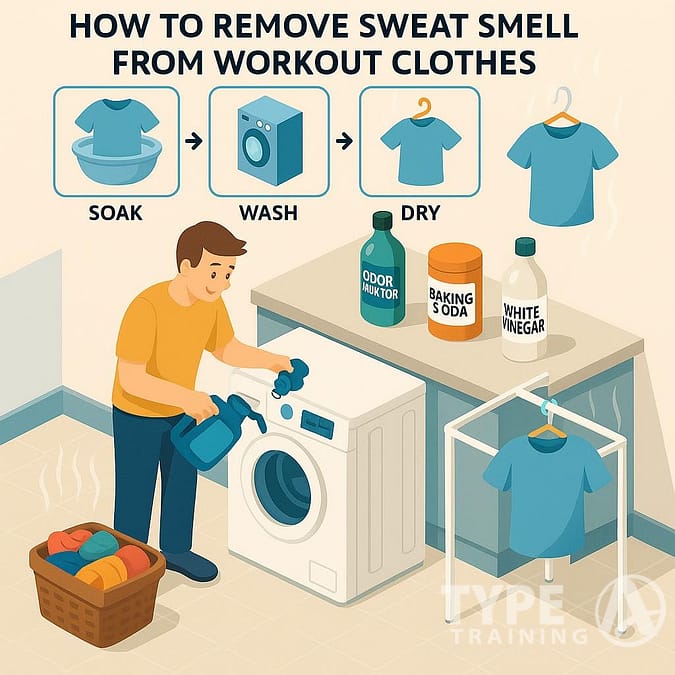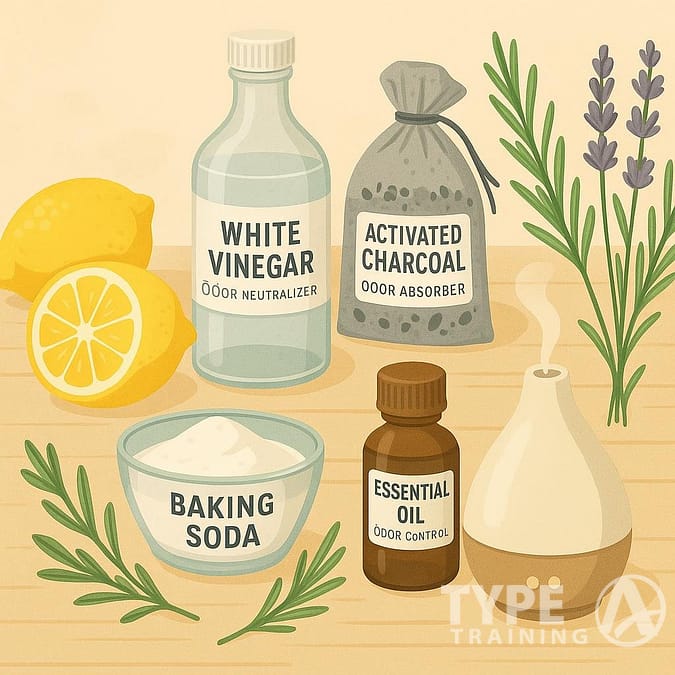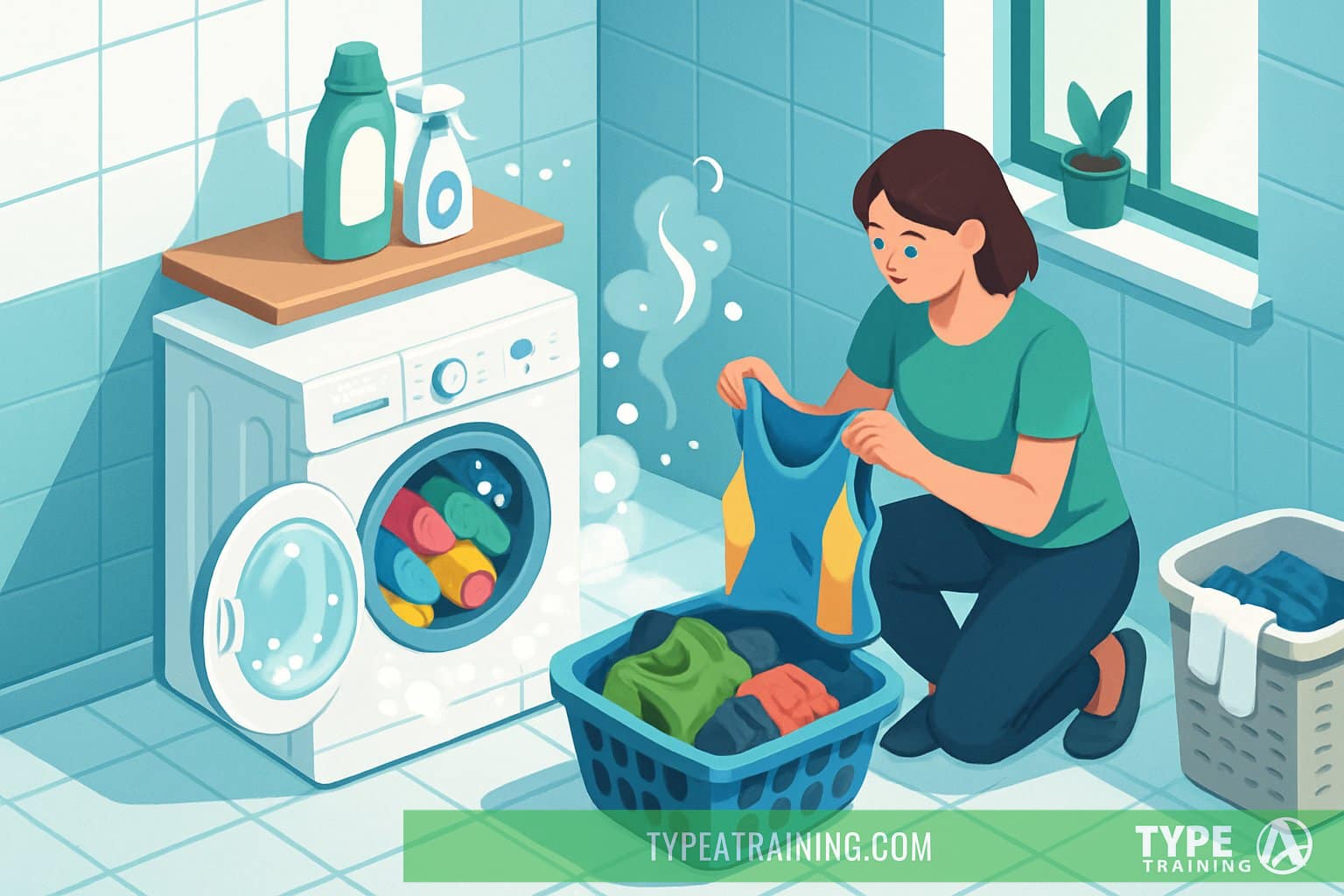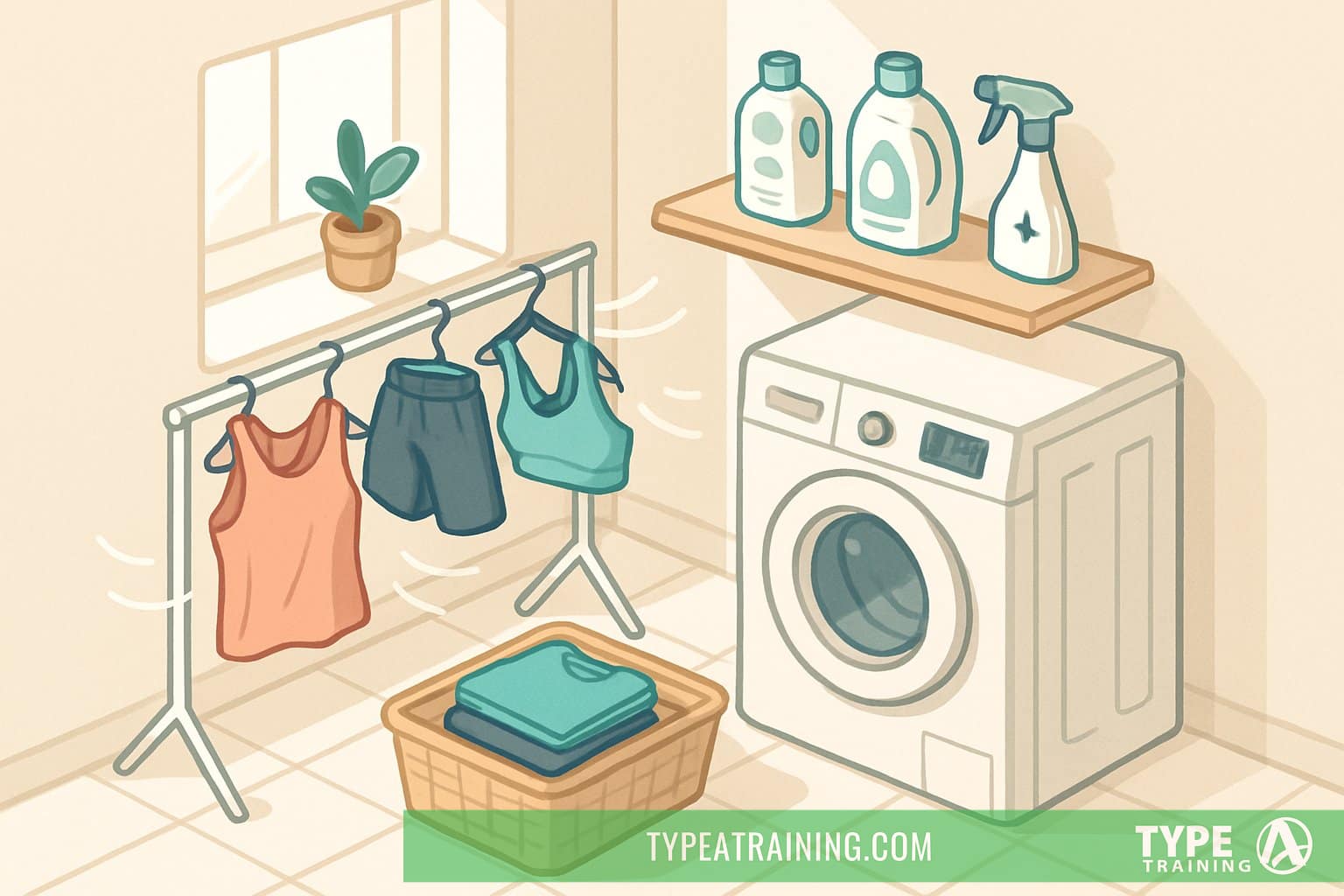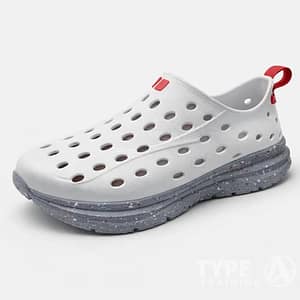You grab your favorite workout shirt, and boom—there’s that stubborn gym funk, even though you swear you washed it. Annoying, right? Sweat mixes with bacteria on fabric, and that combo creates odors that regular washing just doesn’t always knock out.
To remove workout smell effectively, try adding vinegar to your wash or freezing smelly gym clothes until laundry day. Both methods can help kill the bacteria behind those smells and keep your gear fresher.
By following these tips, you can effectively remove workout smell from your clothes and keep them fresh.

Popular posts:
Try adding vinegar to your wash or freezing smelly gym clothes until laundry day. Both methods can help kill the bacteria behind those smells and keep your gear fresher.
To really tackle and remove workout smell, be consistent with your washing routine and use the right products.
Synthetic fabrics in athletic wear wick moisture but also trap bacteria deep in the fibers. When you heat up during a workout, those bacteria release odors, so even a clean shirt can smell like yesterday’s sweat session.
Luckily, with a few tweaks to your laundry routine, you can actually get rid of those lingering smells.
Key Takeaways
- Add white vinegar to your wash cycle to kill odor-causing bacteria in workout clothes
- Experiment with different methods to remove workout smell effectively, such as vinegar or baking soda.
- Wash synthetic athletic wear promptly or freeze them until laundry day to prevent bacteria growth
- Use specialized sport detergents and skip fabric softeners—they trap odors in athletic fabrics
- For persistent odors, pre-soak your clothes to help remove workout smell before washing.
How to Effectively Remove Workout Smell from Your Clothes

Workout clothes often cling to odors, making it crucial to know how to remove workout smell effectively.
Odor-Causing Bacteria and Sweat Residue
Sweat by itself? Not that smelly. The stink comes from bacteria on your skin breaking down sweat’s ingredients.
These bacteria love warm, damp places—like your sweaty gym clothes. When you work out, you produce two types of sweat: eccrine (mostly water and salt) and apocrine (full of proteins and fats).
To eliminate the infamous gym odors, you must remove workout smell from your clothes.
Dead skin cells also get trapped in the fabric, giving bacteria even more to munch on. No wonder the smell gets so stubborn.
Role of Moisture-Wicking and Synthetic Fabrics
Understanding the role of fabrics can help you remove workout smell more efficiently.
Most modern workout clothes use moisture-wicking synthetics that pull sweat off your skin. Great in theory, but it creates a weird problem.
Polyester and nylon, for example, have tiny structures that:
- Pull moisture into the fabric
- Spread it out so it dries faster
- Let it evaporate quickly
But those same microscopic nooks trap bacteria and sweat residue. And since synthetics are hydrophobic (they repel water), sweat doesn’t wash out easily.
On top of that, synthetic fibers can pick up a tiny electrical charge, which attracts body oils. Water alone won’t get those oils out, and bacteria love them.
The Difference Between Cotton and Polyester
Cotton and polyester treat sweat and bacteria pretty differently, which totally changes how they smell after a workout.
Cotton:
- Natural, water-loving fibers
- Soaks up moisture instead of wicking it
- Regular washing is essential to remove workout smell from your clothes.
- Gets drenched during hard workouts
- Usually releases sweat and oils more easily in the wash
- Rarely gets that “perma-stink”
Polyester:
-
- Synthetic, water-repelling fibers
- Makes sweat travel along the fabric instead of soaking in
- Stays lighter, but holds onto oils and bacteria
- Clings to body oils and bacteria
To avoid the dreaded “perma-stink,” it’s crucial to regularly remove workout smell from your workout clothes.
- Can develop a “perma-stink” if not cleaned right
Polyester’s molecular structure just gives more places for smelly compounds to stick. That’s why your synthetic gear can stink even after a wash, while cotton usually smells fine.
Always remember to take steps to remove workout smell after every workout session.
Pre-Wash Steps for Smelly Workout Clothes
How you handle sweaty gym clothes before washing really matters. Pre-treating breaks down the bacteria and makes a big difference.
Your routine should also include methods to remove workout smell effectively.
Promptly Removing and Air-Drying Sweat-Soaked Clothing
Don’t toss damp workout gear into a pile or gym bag and forget about it. That’s a bacteria breeding ground. Instead, pull your clothes out of your bag as soon as you get home.
Shake out the sweaty stuff and hang it up to air-dry before tossing it in the hamper. Airflow keeps bacteria from multiplying while you wait for laundry day.
If you can’t do laundry right away, here’s a weird but effective trick: seal your workout clothes in a plastic bag and stick them in the freezer. Cold stops bacteria growth and nixes odors for a while.
Effective methods to remove workout smell include air drying your workout gear immediately after use.
Set up a drying spot with decent ventilation—hooks in the bathroom or a small rack work fine.
Pre-Soak Solutions for Odor Removal
A good pre-soak can loosen up sweat and bacteria before you even start the wash. Fill a basin with cold water and try one of these:
Effective Pre-Soak Options:
Using pre-soak options can significantly help remove workout smell before the main wash.
- ½ cup white vinegar (kills odors)
- ¼ cup baking soda (absorbs smells)
- 1 cup hydrogen peroxide (zaps bacteria)
- Specialized sports detergent with enzymes
Let your clothes soak for 30 minutes to two hours, depending on how bad the smell is. If it’s really stubborn, overnight soaking can help.
After soaking, rinse in cold water before tossing into the main wash. This step clears out the pre-soak so it doesn’t mess with your detergent.
Best Washing Methods for Eliminating Sweat Smell
Utilizing the best washing methods can effectively remove workout smell from your clothes.
To really get rid of gym stink, you need a laundry routine that targets bacteria. The right detergent, water temp, and machine settings can make a world of difference for fresh workout gear.
Choosing the Right Detergent and Sports Detergents
Honestly, regular detergent just doesn’t cut it for workout clothes. Sports detergents are built to break down sweat and body oils that get stuck in synthetics.
Pick a detergent with enzymes aimed at body soil and odor. Brands like Nathan Sport-Wash, Hex Performance, and WIN go after technical fabrics better than the usual stuff.
Choosing the right detergent is essential to remove workout smell effectively.
Skip fabric softeners completely! They coat your gear, trapping odors and messing with moisture-wicking.
Want a natural boost? Add 1/2 cup of baking soda to your wash. It neutralizes odors and helps your detergent do its thing.
For super-stinky clothes, pre-soak in a cup of white vinegar mixed with cold water for half an hour before your regular wash.
Ideal Water Temperature for Washing
Consideration of water temperature plays a key role in how well you can remove workout smell.
You might think hot water is better, but that’s not always true for workout gear. Most technical fabrics last longer and perform better in cool or cold water.
Cold water (60-80°F) protects elastic fibers and keeps synthetics from breaking down. It also stops odors from setting in.
If you’re washing cotton with tough sweat stains, warm water (80-110°F) can help break down oils. Just avoid hot water—it can wreck technical fabrics and make stains permanent.
For really stubborn smells, try a warm water vinegar pre-soak and then wash in cold with sports detergent.
For maximum effectiveness in removing workout smell, follow the right washing techniques.
Optimal Washing Techniques and Machine Settings
Turn your workout clothes inside-out. The inside gets the sweatiest and needs the most attention. Trust me, it helps.
Use a gentle cycle with a full water level, even if your load is small. That way, detergent and sweat rinse out better.
Try these settings:
- Gentle/delicate cycle
- Extended rinse (if your machine has it)
- Always take steps to remove workout smell from your gear before storing it.
- Medium spin speed
- Don’t cram the machine full
Don’t let sweaty clothes sit around in a hamper or bag. Bacteria multiply fast in damp places, and the stink gets worse. Try to wash within 24 hours if you can.
Skip the dryer—air-dry your workout clothes. Hang them or lay flat. Dryer heat can wreck elastic fibers and lock in odors on technical fabrics.
To ensure your clothes last, a focus on removing workout smell is vital.
Natural and DIY Odor Removal Solutions
When your workout clothes start to smell stubbornly funky, don’t panic. Your kitchen pantry might have the answer.
Natural ingredients like vinegar and baking soda can tackle sweat odors without any harsh chemicals.
Natural ingredients like vinegar and baking soda can be used to remove workout smell effectively.
Using Vinegar and Vinegar Solution
White vinegar’s a surprisingly powerful odor eliminator for gym clothes. Just toss 1/2 cup into your washing machine during the rinse cycle—it’ll help neutralize those stubborn smells.
The acidity in vinegar breaks down the bacteria causing the funk. For clothes that still stink after a wash, mix equal parts water and white vinegar for a pre-soak.
Let your smelly gear soak for 15-30 minutes before washing as usual. This neutralizes acidic odors that regular detergent might leave behind.
Using vinegar solutions can help you remove workout smell even after washing.
If you want to level up, add a few drops of essential oils like tea tree or lavender to your vinegar solution. These oils bring natural antimicrobial power to the mix.
Don’t stress about lingering vinegar scent—it vanishes once your clothes dry.
Baking Soda as a Natural Deodorizer
Baking soda really shines at absorbing and neutralizing odors. It’s a mild alkali that tackles acidic smells in your workout gear.
For stubborn odors, baking soda treatments can effectively remove workout smell from your clothes.
How to use it? Add 1/2 cup right into your wash with detergent. Or, make a paste with water for spot-treating stubborn spots.
-
- Add 1/2 cup directly to your washing machine with detergent
- Create a paste with water for spot-treating especially smelly areas
- Sprinkle dry baking soda on clothes and let sit for 30 minutes before washing
Cleaning your clothes regularly will help ensure you’re able to remove workout smell effectively.
For a stubborn armpit situation, turn clothes inside out and rub on a baking soda paste. Let it dry, brush it off, then wash.
You can also squeeze in a few drops of lemon juice. The citric acid helps break down odor molecules even more.
Avoiding Common Mistakes in Washing Workout Clothes
Taking care of your workout gear isn’t rocket science, but a few easy mistakes can really mess with your clothes. Some habits shorten the life of your favorite leggings and trap odors deep in the fabric.
Risks of Fabric Softeners and Fabric Softener
Fabric softeners and workout clothes? Not a good combo. They leave a coating on your gear that traps bacteria and sweat instead of washing them away.
This residue blocks the moisture-wicking properties that make your clothes comfortable during a workout. Synthetic fabrics like polyester and nylon are built to pull sweat from your skin, but softener basically clogs up those technical fibers with a waxy layer.
To effectively remove workout smell, you should never overload your washing machine.
Skip the softener and add 1/2 cup of white vinegar to the rinse cycle instead. It helps nix odors and keeps your clothes working like they should.
For really stubborn smells, pre-soak your workout clothes in a mix of one part white vinegar to four parts cold water for about 30 minutes before tossing them in the wash.
Impact of Overloading the Washing Machine
Jamming too many clothes into your washer? That’s a classic mistake. Overloading means water and detergent can’t reach every inch of fabric.
Give your sweaty clothes space to move so detergent can get to all surfaces and wash away bacteria. Aim for about 2/3 full—not packed to the brim.
Leaving damp workout gear in a gym bag or hamper? That’s just asking for a stink explosion. Instead, air dry your clothes before tossing them in the hamper. In a pinch, stash them in the freezer to slow down bacteria until wash day.
Oh, and always turn your clothes inside out before washing. Most of the sweat and grime collects on the inside, so that’s where the cleaning needs to happen.
Aftercare: How to Dry and Store Workout Clothes
Proper aftercare is essential to ensure that you can remove workout smell from your clothes.
Drying and storing your workout clothes the right way makes a huge difference in keeping them fresh. It also helps them last longer, which is a win for your wallet.
Best Practices for Air Drying and Hang Drying
Air out your sweaty gear as soon as possible after a workout. Don’t leave damp clothes crumpled up in a bag or basket, or you’ll just feed the bacteria that cause odors.
For synthetic fabrics like polyester and nylon, hang drying is the way to go. Use hangers with clips for shorts and pants, and regular hangers for tops.
Keep your clothes out of direct sunlight, since UV rays can break down elastic fibers and fade colors. Go for a well-ventilated spot with indirect light.
Turn everything inside out before hanging to help the sweatiest parts dry completely. Space things out so air can circulate around each item.
Try to avoid high-heat dryer settings. If you have to use a dryer, stick to the lowest heat or air-dry option to protect those elastic fibers.
Air drying your workout clothes helps to remove workout smell naturally.
Preventing Mildew and Lingering Odors
Make sure your workout clothes are totally dry before you put them away. Even a tiny bit of dampness can lead to mildew and stubborn smells.
Check seams and thicker areas with your fingers—sometimes they stay damp even when the rest feels dry. Store clean clothes in breathable drawers or on open shelves instead of sealed plastic bins.
Mesh laundry bags can help keep things organized and let air flow around your gear. Toss in some cedar blocks or lavender sachets for a natural, chemical-free scent boost.
Taking proper care of your workout gear ensures you can remove workout smell effectively.
For anything that just won’t stop smelling, try a monthly laundry sanitizer treatment to zap lingering bacteria.
Deep Cleaning and Laundry Sanitizing Techniques
Sometimes, regular washing just can’t cut through those stubborn workout odors. You’ll need to go a bit deeper to really get rid of the bacteria hiding in synthetic fibers.
Deep cleaning can help you remove workout smell that regular washing can’t.
When to Use Laundry Sanitizer
Laundry sanitizers are made to kill bacteria that regular detergent might miss. Reach for one if your workout clothes still smell after washing, or if you’ve left them damp in your bag a little too long.
Best times to use sanitizer:
-
- After super sweaty workouts
Utilizing laundry sanitizers can further help you remove workout smell after tough workouts.
- If you’ve trained in humid conditions
- When clothes have developed a persistent stink
- For shared items like yoga mats
Most sanitizers work best during the rinse cycle. That way, the active ingredients hit the fabric directly. Always follow the label for how much to use and what temperature works best.
Sanitizers are especially useful for moisture-wicking fabrics since those can trap bacteria deep inside.
How to Deep Clean Persistent Odors
If your usual routine isn’t working, time for a deep clean. Soaking your smelly gear before washing can make a real difference.
Try these deep cleaning tricks:
Engaging in deep cleaning will help you successfully remove workout smell.
- Vinegar soak: Mix 1 part white vinegar to 4 parts cold water, soak for 30 minutes
- Baking soda paste: Rub onto smelly spots before washing
- Enzyme cleaners: These break down sweat proteins in the fabric
For the worst odors, run a double wash. First, do a quick cycle with vinegar instead of detergent. Then, wash again with a sports-specific detergent.
If you struggle to remove workout smell, consider a specific deep cleaning method.
Skip the fabric softener—it just traps odors and bacteria. Instead, add ½ cup of baking soda for a natural freshen-up. And always dry clothes thoroughly before storing.
Fabric-Specific Tips for Odor Prevention
Not all workout gear is created equal. Each fabric type needs its own care routine if you want to beat stubborn sweat smells.
Tailoring your routine for each fabric type is essential to remove workout smell effectively.
Caring for Synthetic and Performance Fabrics
Synthetics and moisture-wicking fabrics can trap bacteria deep inside, which leads to persistent odors. You’ll need to break down the oils and sweat that hang on tight.
Pre-treat like this:
-
- Soak in a white vinegar solution (1 part vinegar, 4 parts water) for 30 minutes
- Use enzyme-based detergents made for activewear
- Skip fabric softeners—they just seal in odors
Pre-treating workout gear can significantly aid in the goal to remove workout smell from your clothes.
Always turn your performance gear inside out before washing. That way, detergent hits the sweatiest spots first.
For tough odors in polyester and nylon, toss ½ cup baking soda into your wash. It neutralizes odors without messing up your gear’s wicking power.
Special Considerations for Wool and Heavy Fabrics
Wool workout clothes have that natural antimicrobial edge, but you really have to clean them gently. Otherwise, you’ll wreck their odor-fighting powers and end up with clothes that shrink or just don’t feel right anymore.
Even wool can develop odors, so knowing how to remove workout smell is crucial.
Wool care essentials:
- Stick to cold water washes
- Pick wool-specific detergents without enzymes
- Lay flat to air dry so they keep their shape
- Skip bleach and absolutely avoid hot water
Heavier cotton-blend fabrics? Give them a pre-soak in a baking soda and water mix. That trick really helps with those stubborn, trapped odors before you toss them in the wash.
Sports-specific enzymatic cleaners work wonders on heavy fabrics. Rub some directly onto armpits and any other areas that get extra sweaty.
When you’re putting workout clothes away, make sure they’re bone dry. Even a little dampness can bring back that unwanted funk.
At all stages, keep the goal in mind: to effectively remove workout smell from your activewear.
Creating an Effective Laundry Routine for Activewear
Honestly, having a solid laundry routine makes all the difference for keeping your workout gear fresh. If you keep up with it, your clothes last longer and you don’t have to deal with that set-in smell.
Routine Maintenance to Prevent Smelly Clothes
Try to wash your activewear right after each workout. If you let sweaty clothes hang out in your gym bag or hamper for hours, you’re basically inviting bacteria to throw a party.
Flip your clothes inside out before washing. The inside is where all the sweat and skin cells end up—bacteria love that stuff.
Hit smelly spots with a dab of liquid detergent before washing. Let it sit on underarms or other trouble zones for about 10-15 minutes.
Don’t overdo it with the detergent. Too much leaves behind residue that just traps odors. Go with a detergent made for activewear if you can.
Use cold water and a gentle cycle. That way, you help those elastic fibers and moisture-wicking features last longer.
Storing Clean Gym Clothes Properly
Make sure your activewear is totally dry before you stash it away. Any leftover moisture just invites odor-causing bacteria, and nobody wants that.
Skip the plastic storage bins—they tend to lock in humidity. I usually go for cotton bags or drawers that let air move around.
By following these guidelines, you can successfully remove workout smell and keep your gear fresh.
If you can’t toss sweaty clothes in the wash right away, stick them in a plastic bag in the freezer. That way, the cold puts bacteria on pause until laundry day.
Keep your clean workout gear in a cool, dry spot, far from direct sunlight. Too much UV can mess with the fabric’s stretchiness over time.
Always separate clean clothes from dirty ones, especially when you’re traveling. It just makes sense—you don’t want bacteria jumping from item to item.
Always remember that a consistent effort is necessary to effectively remove workout smell.

